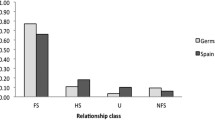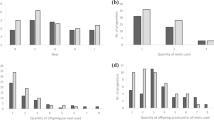Abstract
In this study we examined parentage within broods of the cooperatively breeding noisy miner using multi-locus DNA profiling. Previous studies of noisy miners described them as highly promiscuous, leading to the suggestion that promiscuous mating behaviour was a tactic used by females to recruit males as provisioners to their nests (Dow 1978). At our study site in south-east Queensland, Australia, we found that both multiple and extra-group paternity (i.e. a female mating with a male outside the group of male provisioners at her nest) were rare. In nests where multiple paternity was possible (i.e. clutch size > 1) 97% of 31 broods were sired by only a single male. Overall, 96.5% of all nestlings (n = 85) were the result of monogamous matings. Also, at the vast majority of nests, the male that sired the nestlings was also the main provisioner among all male nest attendants. Our results show that the mating system of the noisy miner can no longer be considered cooperative polyandry (Brown 1987) but is clearly genetic monogamy. We discuss the implications of this finding for understanding the complex social system of this species.
Similar content being viewed by others
References
Brown JL (1987) Helping and communal breeding in birds. Princeton University Press, Princeton
Burke T, Bruford MW (1987) DNA fingerprinting in birds. Nature 327:149–152
Burke T, Davies NB, Bruford MW, Hatchwell BJ (1989) Parental care and mating behaviour of polyandrous dunnocks Prunella modularis related to paternity by DNA fingerprinting. Nature 338:249–251
Clarke MF (1984) Cooperative breeding in the Australian bell miner, Manorina melanophrys Latham: a test of kim selection theory. Behav Ecol Sociobiol 14:137–146
Clarke MF (1988) The reproductive behaviour of the bell miner, Manorina melanophrys. Emu 88:88–100
Clarke MF (1989) The pattern of helping in the bell miner (Manorina melanophrys). Ethology 80:292–306
Dow DD (1975) Displays of the honeyeater Manorina melanocephala. Z Tierpsychol 38:70–96
Dow D (1978) Reproductive behavior of the noisy miner, a communally breeding honeyeater. Living Bird 16:163–185
Dow DD (1979a) The influence of nests on the social behaviour of males in Manorina melanocephala, a communally breeding honeyeater. Emu 71–83
Dow DD (1979b) Agonistic and spacing behaviour of the noisy miner, Manorina melanocephala, a communally breeding honeyeater. Ibis 121:423–436
Dow DD, Whitmore MJ (1990) Noisy miners: variations on the theme of communality. In: Stacey PB, Koenig WD (eds) Cooperative breeding in birds. Cambridge University Press, Cambridge, pp 559–592
Emlen S (1986) Cooperative breeding in birds and mammals. In: Krebs JR, Davies NB (eds) Behavioural ecology, 2nd edn. Blackwell, Oxford, pp 301–337
Emlen ST, Vehrencamp SL (1983) Cooperative breeding strategies among birds. In: Brush AH, Clark GA (eds) Perspectives in ornithology. Cambridge University Press, Cambridge, pp 93–120
Emlen ST, Wrege PH (1992) Parent-offspring conflict and recruitment of helpers among bee-eaters. Nature 356:331–333
Hartley IR, Davies NB (1994) Limits to cooperative polyandry in birds. Proc R Soc Lond 257:67–73
Hill GE, Montgomerie R, Roeder C, Boag PT (1994) Sexual selection and cuckoldry in a monogamous songbird: implications for sexual selection theory. Behav Ecol Sociobiol 35:193–199
Hoysak DJ, Weatherhead PJ (1991) Sampling blood from birds: a technique and an assessment of its effect. Condor 93:746–752
Jamieson IG, Quinn JS, Rose PA, White BN (1994) Shared paternity among non relatives is a result of an egalitarian mating system in a communally breeding bird, the pukeko. Proc R Soc Lond 257:271–277
Jeffreys AJ, Wilson V, Thein SL (1985) Hypervariable “minisatellite” regions in human DNA. Nature 314:67–73
Ligon JD, Ligon SH (1990) Green woodhoopoes: life history traits and sociality. In: Stacey PB, Koenig WD (eds) Cooperative breeding in birds. Cambridge University Press, Cambridge, pp 31–66
Mulder RA, Dunn OP, Cockburn A, Lazenby-Cohen KA, Howell MJ (1994) Helpers liberate female fairy-wrens from constraints on extra-pair mate choice. Proc R Soc Lond 255:223–229
Packer C, Gilbert DA, Pusey AE, O'Brien SJ (1991) A molecular analysis of kinship and cooperation in African lions. Nature 351:562–565
Seutin G, White BN, Boag PT (1991) Preservation of avian blood and tissue samples for DNA analyses. Can J Zool 69:82–90
Shin HS, Bargiello TA, Clark BT, Jackson FR, Young MW (1985) An unusual coding sequence from a Drosophila clock gene is conserved in vertebrates. Nature 317:445–448
Smith HG, Montgomerie R, Põldmaa T, White BN, Boag PT (1991) DNA fingerprinting reveals relation between tail ornaments and cuckoldry in barn swallows, Hirundo rustica. Behav Ecol 2:90–98
Stacey PB (1982) Female promiscuity and male reproductive success in social birds and mammals. Am Nat 120:51–64
Stacey PB, Koenig WD (1990) Cooperative breeding in birds. Cambridge University Press, Cambridge
Vehrencamp SL (1983) A model for the evolution of despotic versus egalitarian societies. Anim Behav 31:667–682
Westneat D (1990) Genetic parentage in the indigo bunting: a study using DNA fingerprinting. Behav Ecol Sociobiol 27:67–76
Westneat DF (1993) Polygyny and extrapair fertilisations in eastern red-winged blackbirds (Agelaius phoeniceus). Behav Ecol 4: 49–60
Wetton JH, Carter RE, Parkin DT, Walters D (1987) Demographic study of a wild house sparrow population by DNA fingerprinting. Nature 327:147–149
Woolfenden GE, Fitzpatrick JW (1990) Florida scrub jays: a synopsis after 18 years of study. In: Stacey PB, Koenig WD (eds) Cooperative breeding in birds. Cambridge University Press, Cambridge, pp 239–266
Author information
Authors and Affiliations
Additional information
Communicated by W. A. Searcy
Rights and permissions
About this article
Cite this article
Põldmaa, T., Montgomerie, R. & Boag, P. Mating system of the cooperatively breeding noisy miner Manorina melanocephala, as revealed by DNA profiling. Behav Ecol Sociobiol 37, 137–143 (1995). https://doi.org/10.1007/BF00164159
Received:
Accepted:
Issue Date:
DOI: https://doi.org/10.1007/BF00164159




